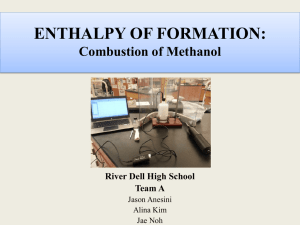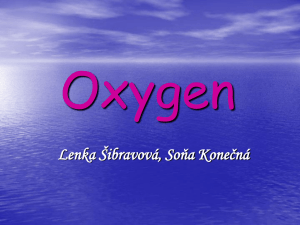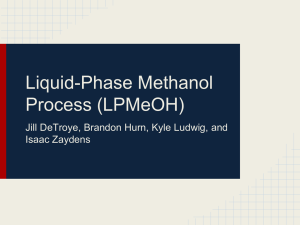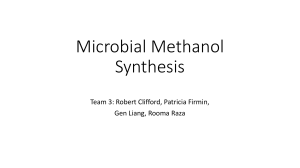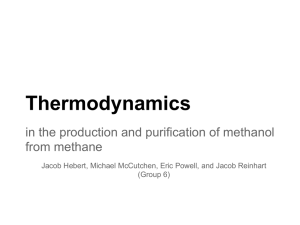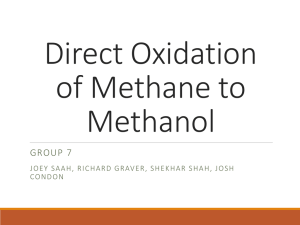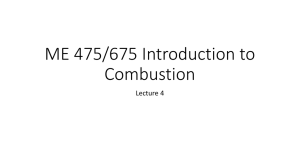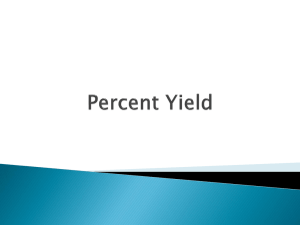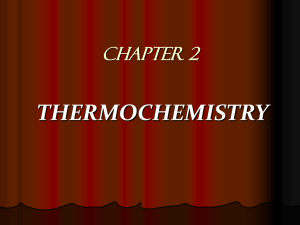Document
advertisement
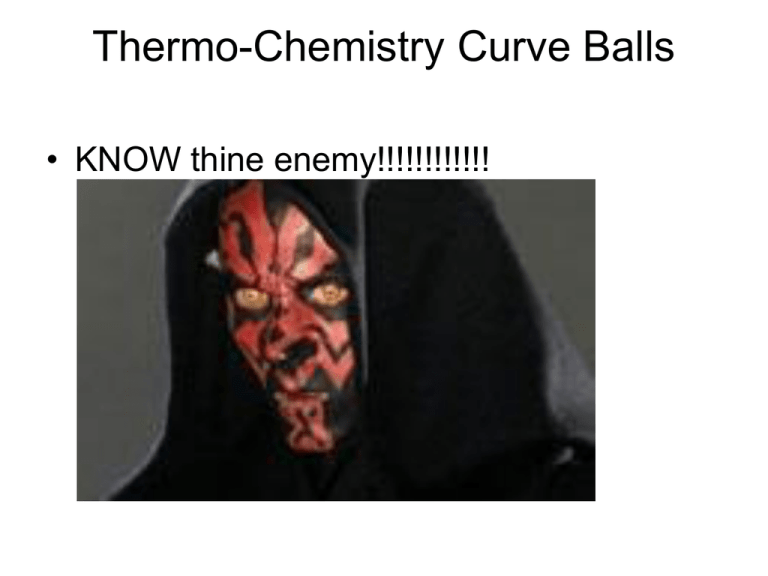
Thermo-Chemistry Curve Balls • KNOW thine enemy!!!!!!!!!!!! Equations • • • • • • • • • q = m C ΔT q = m Hx q = ΔHo ΔHo = products – reactants ΔHo = broken – formed (not on equation sheet) ΔSo = products – reactants ΔGo = products – reactants ΔGo = ΔHo - T ΔSo ΔGo =-RTlnK CH3OH + O2 CO2 + H2O (l) 1. What is the enthalpy of combustion, ΔHoc, for the complete combustion of methanol to produce carbon dioxide and liquid water? CH3OH + XO2 CO2 + YH2O (l) • 1. What is the enthalpy of combustion, ΔHoc, for the complete combustion of methanol to produce carbon dioxide and liquid water? • Mistake made: unbalance equation. Any test any year (basic chemistry mistake) • ΔHco = products – reactants • ΔHco = [-393.5 + -285.8] – [-210.0] • ΔHco = -469.3 kJ/mole of methanol CH3OH + 1.5O2 CO2 + 2H2O (l) • 1. What is the enthalpy of combustion, ΔHoc, for the complete combustion of methanol to produce carbon dioxide and liquid water? • Mistake made: water gas instead of liquid Any test any year (basic chemistry mistake) • • • • • ΔHco = products – reactants ΔHco = [-393.5 + -241.5] – [-210.0] unbalanced ΔHco = -425 kJ/mole of methanol ΔHco = [-393.5 + 2(-241.5)] – [-210.0] balanced ΔHco = -666.5 kJ/mole of methanol • 21/03. Calculate the amount of energy mol-1) • released when 0.100 mol of • diborane, B2H6, reacts with • oxygen to produce solid B2O3 • and steam. • ∆Hf° kJ • B2H6(g) 35 • B2O3(s) -1272 • H2O(l) -285 • H2O(g) -241 *(A) 2030 kJ (B) 2160 kJ (C) 3300kJ (D) 3430 kJ B2H6 + 3O2 B2O3 + 3H2O (g) ∆H = [-1272 + 3(-241)] – 35 CH3OH + 1.5O2 CO2 + 2H2O (l) • 1. What is the enthalpy of combustion, ΔHoc, for the complete combustion of methanol to produce carbon dioxide and liquid water? • Mistake made: reactants – products Any test any year (basic chemistry mistake) • ΔHco = reactants - products • ΔHco = [-210.0] – [-393.5 + -285.8] unbalanced ΔHco = 469.3 kJ/mole of methanol • ΔHco = [-210.0] – [-393.5 + 2(-285.8)] balanced ΔHco = 755.1 kJ/mole of methanol CH3OH + 1.5O2 CO2 + 2H2O (l) • 1. What is the enthalpy of combustion, ΔHoc, for the complete combustion of methanol to produce carbon dioxide and liquid water? • • • • Correct answer: ΔHco = products – reactants ΔHco = [-393.5 + 2(-285.8)] – [-210.0] ΔHco = -755.1 kJ/mole of methanol Correct way – This type of enthalpy problem (just a products – reactants ) is more often found on the multiple choice test and usually involves a little easier number to add and subtract. • In a multiple choice problem a student should round – DO NOT get bogged down in mathematics! • -393.5 rounds to -400 • -285.8 rounds to -300 • -210 rounds to -200 • ΔHco = [-400 + 2(-300)] – [-200] • ΔHco = -1000 - -200 • ΔHco = around -800 the correct answer is -755.1 • The answer should be less than ( more positive) 800 because the rounding up of the product’s enthalpies CH3OH + 1.5O2 CO2 + 2H2O (l) 2. What is the heat of formation, ΔHof , of methanol if one mole of methanol reacts with excess oxygen to produce carbon dioxide, liquid water, and 755.1 kJ of heat? OR the equation could have the heat included CH3OH + 1.5O2 CO2 + 2H2O (l) + 755.1 kJ CH3OH + 1.5O2 CO2 + 2H2O (l) 2. What is the heat of formation, ΔHof , of methanol if one mole of methanol reacts with excess oxygen to produce carbon dioxide, liquid water, and 755.1 kJ of heat? OR the equation could have the heat included CH3OH + 1.5O2 CO2 + 2H2O (l) + 755.1 kJ • Mistake made: ignore the sign of the enthalpy Question #3b 1998 +755.1 = [-393.5 + 2(-285.8)] – [ΔHof] +755.1 = -965.1 -x • ΔHof = -1720.2 kJ/mole CH3OH + 1.5O2 CO2 + 2H2O (l) 2. What is the heat of formation, ΔHof , of methanol if one mole of methanol reacts with excess oxygen to produce carbon dioxide, liquid water, and 755.1 kJ of heat? OR the equation could have the heat included CH3OH + 1.5O2 CO2 + 2H2O (l) + 755.1 kJ • Mistake made: incorrect substitution ( no true understanding between formation and combustion) and sign problem. Question #3b 1998 “ΔHof “ = [-393.5 + 2(-285.8)] – [755.1] confused between combustion and formation ΔHof = -1720.2 kJ/mole 2CH3OH + 3O2 2CO2 + 4H2O (l) 2. What is the heat of formation, ΔHof , of methanol if one mole of methanol reacts with excess oxygen to produce carbon dioxide, liquid water, and 755.1 kJ of heat? OR the equation could have the heat included 2CH3OH + 3O2 2CO2 + 4H2O (l) + 755.1 kJ • Mistake made: over balancing the equation leading to a stoich mistake. Any test any year • -755.1 = [2(-393.5) + 4(-285.8)] – [2x] doubled everything BUT the molar enthalpy of combustion • ΔHof = -587.6 2CH3OH + 3O2 2CO2 + 4H2O (l) 2. What is the heat of formation, ΔHof , of methanol if one mole of methanol reacts with excess oxygen to produce carbon dioxide, liquid water, and 755.1 kJ of heat? OR the equation could have the heat included 2CH3OH + 3O2 2CO2 + 4H2O (l) + 755.1 kJ • Mistake made: over balancing the equation leading to a stoich mistake. Any test any year 2(-755.1) = [2(-393.5) + 4(-285.8)] – [x] doubled everything BUT the molar enthalpy of formation • ΔHof = -420 2CH3OH + 3O2 2CO2 + 4H2O (l) 2. What is the heat of formation, ΔHof , of methanol if one mole of methanol reacts with excess oxygen to produce carbon dioxide, liquid water, and 755.1 kJ of heat? OR the equation could have the heat included 2CH3OH + 3O2 2CO2 + 4H2O (l) + 755.1 kJ • Mistake made: incorrect substitution • “ΔHof “ = [2(-393.5) + 4(-285.8)] – [2(-755.1)] confused between combustion and formation • “ΔHof “ = -420 kJ/mole CH3OH + 1.5O2 CO2 + 2H2O (l) 2. What is the heat of formation, ΔHof , of methanol if one mole of methanol reacts with excess oxygen to produce carbon dioxide, liquid water, and 755.1 kJ of heat? OR the equation could have the heat included CH3OH + 1.5O2 CO2 + 2H2O (l) + 755.1 kJ • Correct answer: -755.1 = [-393.5 + 2(-285.8)] – [x] • ΔHof = -210.0 kJ/mole CH3OH + 1.5O2 CO2 + 2H2O (l) 3. What is the heat of combustion , ΔHoc , of methanol if 24.75 grams of methanol reacts with excess oxygen to produce carbon dioxide, liquid water, and 584.1 kJ of heat? CH3OH + 1.5O2 CO2 + 2H2O (l) 3. What is the heat of combustion , ΔHoc , of methanol if 24.75 grams of methanol reacts with excess oxygen to produce carbon dioxide, liquid water, and 584.1 kJ of heat? • A common student mistake is to underestimate the test writer and believe the answer is as easy as picking it out of the question . (-584.1kJ) CH3OH + 1.5O2 CO2 + 2H2O (l) 3. What is the heat of combustion , ΔHoc , of methanol if 24.75 grams of methanol reacts with excess oxygen to produce carbon dioxide, liquid water, and 584.1 kJ of heat? Mistake made: incorrect molar substitution Question #3a 1998, 1979 ΔHoc = [-393.5 + 2(-285.8)] – [-584.1] ΔHoc = -381.0kJ/mol CH3OH + 1.5O2 CO2 + 2H2O (l) 3. What is the heat of combustion , ΔHoc , of methanol if 24.75 grams of methanol reacts with excess oxygen to produce carbon dioxide, liquid water, and 584.1 kJ of heat? • Mistake made: incorrect molar substitution • -584.1 = [-393.5 + 2(-285.8)] – [ΔHof] • ΔHof = -381kJ/mol • OR use the wrong enthalpy with the wrong sign: 584.1 = [-393.5 + 2(-285.8)] – [ΔHof] • ΔHof = -1549.2kJ/mol CH3OH + 1.5O2 CO2 + 2H2O (l) 3. What is the heat of combustion , ΔHoc , of methanol if 24.75 grams of methanol reacts with excess oxygen to produce carbon dioxide, liquid water, and 584.1 kJ of heat? Correct way 24.75g = 32 g -584.1kJ x kJ x = [-393.5 + 2(-285.8)] – [ΔHof] -755.1 = [-393.5 + 2(-285.8)] – [ΔHof] ΔHof = -210.0 kJ/mole Chemistry Olympiad Question • 25/00. What is the standard enthalpy of formation of MgO(s) if 300.9 kJ is evolved when 20.15 g of MgO(s) is formed by the combustion of magnesium under standard conditions? *(A) –601.8 kJ·mol–1 (B) –300.9 kJ·mol–1 +300.9 kJ·mol–1 (D) +601.8 kJ·mol–1 20.15/300.9 = 40/X kJ (C) CH3OH + 1.5O2 CO2 + 2H2O (l) 4. If 8.95 grams of methanol was used to heat 1500 mL of water from 25oC to 58.7 oC What is the molar enthalpy of combustion of methanol? CH3OH + 1.5O2 CO2 + 2H2O (l) 4. If 8.95 grams of methanol was used to heat 1500 mL of water from 25oC to 58.7 oC What is the molar enthalpy of combustion of methanol? • Mistake made: q/grams ≠ ΔH/mole Question #3a 1998, #d 1995, 1979,1989b, 2001a • q = 1500g x 4.18 J/ g x oC (58.7 oC – 25 oC) q = 211299 joules of heat/ 8.95 grams of methanol combusted • ( but the question wanted the molar enthalpy) CH3OH + 1.5O2 CO2 + 2H2O (l) 4. If 8.95 grams of methanol was used to heat 1500 mL of water from 25oC to 58.7 oC What is the molar enthalpy of combustion of methanol? • Mistake made: increase in temperature = + ΔHoc • +q = 1500g x 4.18 J/ g x oC (58.7 oC – 25 oC) • +q = +211299 joules of heat/ 8.95 grams of methanol combusted • 8.95 grams of methanol = 32 grams /mole • +211299 joules x • 755482J / mole +755 kJ/mole CH3OH + 1.5O2 CO2 + 2H2O (l) 4. If 8.95 grams of methanol was used to heat 1500 mL of water from 25oC to 58.7 oC What is the molar enthalpy of combustion of methanol? • Correct answer : • q = 1500g x 4.18 J/ g x oC (58.7 oC – 25 oC) • q = 211299 joules of heat/ 8.95 grams of methanol combusted • 8.95 grams of methanol = 32 grams /mole • - 211299 joules x • -755482J / mole -755 kJ/mole CH3OH + 1.5O2 CO2 + 2H2O (l) 5. If 8.95 grams of methanol was used to heat 1500 mL of water from 25oC to 58.7 oC What is the molar enthalpy of formation of methanol? Mistake made: ΔHof ≠ • • • • • • ΔHoc Wrong answer: q = 1500g x 4.18 J/ g x oC (58.7 oC – 25 oC) q = 211299 joules of heat/ 8.95 grams of methanol combusted 8.95 grams of Methanol = 32.0 grams /mole Methanol - 211299 joules x -755482J / mole -755 kJ/mole the student found the heat of combustion correctly but then uses it incorrectly as the heat of formation: • ΔHoc = [-393.5 + 2(-285.8)] – [ -755] incorrect substitution • ΔHoc = -210.1 correct answer found the wrong way • This error IF caught should send a red flag to the teacher that this student does not know the difference between enthalpy of reaction and enthalpy of formation. CH3OH + 1.5O2 CO2 + 2H2O (l) 5. If 8.95 grams of methanol was used to heat 1500 mL of water from 25oC to 58.7 oC What is the molar enthalpy of formation of methanol? • Correct answer: • q = 1500g x 4.18 J/ g x oC (58.7 oC – 25 oC) • q = 211299 joules of heat/ 8.95 grams of methanol combusted • 8.95 grams of methanol = 32.0 grams /mole • - 211299 joules x • -755 = [-393.5 + 2(-285.8)] – [ΔHof] correct substitution • ΔHof = -210.1 kJ/mole CH3OH + 1.5O2 CO2 + 2H2O (g) 6. Calculate the enthalpy of reaction for the combustion of one mole of methanol with excess oxygen to produce carbon dioxide and gaseous water? CH3OH + 1.5O2 CO2 + 2H2O (g) 6. Calculate the enthalpy of reaction for the combustion of one mole of methanol with excess oxygen to produce carbon dioxide and gaseous water? • Mistake made: ΔHof(water gas) ≠ ΔHof (water liquid) • ΔHco = [-393.5 + 2( -285.8)] – [-210.0] • ΔHco = -755.1 kJ/mole of methanol CH3OH + 1.5O2 CO2 + 2H2O (g) 6. Calculate the enthalpy of reaction for the combustion of one mole of methanol with excess oxygen to produce carbon dioxide and gaseous water? • ΔHoc = [-393.5 + 2(-241.5)] – [ -210.0] = -666.5kJ • OR • CH3OH + 1.5O2 CO2 + 2H2O (l) -755 • 2H2O(l) 2H2O(g) (-88.5) • ΔHoc = -666.5kJ • ΔHov= 2[-285.8] - 2[-241.5] • ΔHov = -88.5 CH3OH + 1.5O2 CO2 + 2H2O (l) 7. Using the table bond enthalpies calculate the molar enthalpy for the combustion of methanol with excess oxygen to produce carbon dioxide and liquid water. • C-H 413 • O=O 495 • C-O 358 • O-H 463 • C=O 799 CH3OH + 1.5O2 CO2 + 2H2O (l) 7. Using the table bond enthalpies calculate the molar enthalpy for the combustion of methanol with excess oxygen to produce carbon dioxide and liquid water. • C-H 413 O=O 495 • C-O 358 O-H 463 • C=O 799 Mistake made formed - broken C=O H-O C-H C-O O-H O=O • ΔHoc = [ 2(799) + 4(463) ]- [ 3(413) + 358 + 463 + 1.5(495)] • 3450 - • ΔHoc = +647.5 2802.5 CH3OH + 1.5O2 CO2 + 2H2O (l) 7. Using the table bond enthalpies calculate the molar enthalpy for the combustion of methanol with excess oxygen to produce carbon dioxide and liquid water. • C-H 413 O=O 495 • C-O 358 O-H 633 • C=O 799 • Mistake made: bonds ≠ coefficients • CH3OH + 1.5O2 CO2 + 2H2O (l) • ΔHoc = [ (413) + ( 463) + 1.5(495)] – [ (799) – 2(463)] • ΔHoc = -106.5 Correct Way • Correct answer: Must have structural formula • H • | • H—C –O-H + 1.5 O=O O=C=O + H-O-H • | H-O-H • H • C-H C-O O-H O=O C=O H-O • ΔHoc = [ 3(413) + 358 + 463 + 1.5(495)] - [ 2(799) + 4(463) ] • 2802.5 3450 • ΔHoc = - 647.5kJ/mole • Bond enthalpies give different enthalpy of combustion because they don’t take into account intermolecular forces. (good essay question!) Chemistry Olympiad Question • 23/02. Estimate ∆H for this reaction. • H2(g) + Cl2(g) 2HCl(g) Bond Energies, kJ·mol–1 H–H 436 Cl–Cl 243 H–Cl 431 (A) 1110 kJ (B) 248 kJ *(C) –183 kJ (D) –248 kJ ΔH = broken - formed ΔH = [H-H + Cl-Cl] – [ 2(H-Cl)] ΔH = [436 +243] – [ 2(431)] CH3OH + 1.5O2 CO2 + 2H2O (l) 8. The complete combustion of 10.5 g of methanol will produce carbon dioxide, liquid water and 217.7 kJ of heat. Calculate the bond enthalpy of a oxygen hydrogen single bond CH3OH + 1.5O2 CO2 + 2H2O (l) 8. The complete combustion of 10.5 g of methanol to produce carbon dioxide, liquid water and 217.7 kJ of heat. Calculate the bond enthalpy of a oxygen hydrogen single bond. Mistake made: sign mistake or incorrect substitution or both! C-H C-O O-H O=O C=O O-H • -217.7 = [ 3(413) + 358 + x + 1.5(495)] - [ 2(799) + 4(x) ] • ΔHobond = 319.7 kJ/mole • C-H C-O O-H O=O C=O O-H • 217.7 = [ 3(413) + 358 + x + 1.5(495)] - [ 2(799) + 4(x) ] • ΔHobond = 174.6 kJ/mole CH3OH + 1.5O2 CO2 + 2H2O (l) 8. The complete combustion of 10.5 g of methanol to produce carbon dioxide, liquid water and 217.7 kJ of heat. Calculate the bond enthalpy of a oxygen hydrogen single bond. 10.5 g = 32 g/mol -217.7kJ = xkJ X= -663.5 C-H C-O O-H O=O C=O O-H -663.5 = [ 3(413) + 358 + x + 1.5(495)] - [ 2(799) + 4(x) ] -663.5 = [2339.5 +x ] – [1598 -4x] -663.5 = 741.5 -3x • ΔHobond = 468.3 kJ/mole CH3OH + 1.5O2 CO2 + 2H2O (l) 9. Calculate the entropy of reaction for the combustion of one mole of methanol with excess oxygen to produce carbon dioxide and liquid water? CH3OH + 1.5O2 CO2 + 2H2O (l) • 9. Calculate the entropy of reaction for the combustion of one mole of methanol with excess oxygen to produce carbon dioxide and liquid water? • Mistake made: UNITS • ΔSo = [214+2(70)] – [238 + 1.5(205)] • 354 - 545.5 • ΔSo = -191.5 J/mole • Some will even try kJ • Correct math – just a foot shot on units! CH3OH + 1.5O2 CO2 + 2H2O (l) • 9. Calculate the entropy of reaction for the combustion of one mole of methanol with excess oxygen to produce carbon dioxide and liquid water? • • • • • Correct Way ΔSo = [214+2(70)] – [238 + 1.5(205)] 354 - 545.5 ΔSo = -191.5 J/K x mole Must have Kelvin CH3OH + 1.5O2 CO2 + 2H2O (l) 10. What is the value of the standard free energy for the combustion of methanol. CH3OH + 1.5O2 CO2 + 2H2O (l) 10. What is the value of the standard free energy for the combustion of methanol. • Mistake made: enthalpy - entropy units • ΔGoc = ΔHoc – TΔSoc • ΔGoc =-755.1kJ – 298(-191.5J) • ΔGoc = 56311.9???? Units • ΔHoc from enthalpies of formation not bond energies ( either is OK) =-755.1kJ CH3OH + 1.5O2 CO2 + 2H2O (l) 10. What is the value of the standard free energy for the combustion of methanol. • Mistake made: Kelvin units • ΔGoc = ΔHoc – TΔSoc • ΔGoc =-755.1 – 25oC (-0.1915) • ΔGoc =-750.3 CH3OH + 1.5O2 CO2 + 2H2O (l) 10. What is the value of the standard free energy for the combustion of methanol. • Correct Way • ΔGoc = ΔHoc – TΔSoc • ΔGoc =-755.1 – 298(-0.1915) • ΔGoc = -698 kJ CH3OH + 1.5O2 CO2 + 2H2O (l) 11. What is the value of the free energy for the formation of methanol. CH3OH + 1.5O2 CO2 + 2H2O (l) 11. What is the value of the free energy for the formation of methanol. • Mistake made: absolute entropy does not equal entropy of formation • ΔGof = ΔHof – TΔSof • ΔGof =-201 – 298(0.238) 238J/k x mol from data of absolute entropies • ΔGof =-271.9 kJ CH3OH + 1.5O2 CO2 + 2H2O (l) 11. What is the value of the free energy for the formation of methanol. • ΔGof = ΔHof – TΔSof C + 0.5 O2 + 2H2 CH3OH • ΔSof = 240 – [6 + 0.5(205) + 2(131)] • ΔSof = -130.5 J/K • -201 ΔHof(methanol) from data table • ΔGof =-201 – 298(-0.1305) • ΔGof = -162.1 kJ R = 8.31 - WHAT • • • • • • • • • Force = mass x acceleration Force = 10,000kg x 9.8 m/s2 Force = 1.0 x 105 kgxm/s2 Pressure = force / area Pressure = 1.0 x 105 kgxm/s2/m2 Units of pressure = kg /s2m Work = pressure x ΔVol Work (Joules) = kg /s2m x m3 Joules = kg xm2 /s2 CH3OH + 1.5O2 CO2 + 2H2O (l) 12. What is the equilibrium constant for the combustion of methanol? CH3OH + 1.5O2 CO2 + 2H2O (l) 12. What is the equilibrium constant for the combustion of methanol? • • • • • Mistake made: units of R ΔGo = -RTlnK ΔGo =-698kJ -698kJ = - 8.31J x 298 lnK K= 1.33 CH3OH + 1.5O2 CO2 + 2H2O (l) 12. What is the equilibrium constant for the combustion of methanol? • • • • • Mistake made: wrong R ΔGo = -RTlnK ΔGo =-698kJ -698000J = - 0.0821 “J” x 298 lnK K= error (time killer) CH3OH + 1.5O2 CO2 + 2H2O (l) 12. What is the equilibrium constant for the combustion of methanol? • • • • • Mistake made: 2nd ln ΔGo = -RTlnK ΔGo =-698kJ -698000J = - 8.31J x 298 lnK K= 281.9 has not taken the antilog CH3OH + 1.5O2 CO2 + 2H2O (l) 12. What is the equilibrium constant for the combustion of methanol? • • • • • Mistake made: wrong LOG ΔGo = -RTlnK ΔGo =-698kJ -698000J = - 8.31J x 298 log K K= error ???? ( time killer) CH3OH + 1.5O2 CO2 + 2H2O (l) 12. What is the equilibrium constant for the combustion of methanol? • • • • • • Correct Way ΔGo = -RTlnK ΔGo =-698kJ -698000J = - 8.31J x 298 lnK lnK= 281.9 K= error -- too big ?? x 10100 or more • Combustion reactions are not the norm for ΔGo = -RTlnK equation weak acid /base, Ksp, Kp are better suited…… Essay -ΔH -ΔH +ΔH +ΔH +ΔS always spontaneous -ΔG -ΔS decrease temperature more spontaneous -ΔG +ΔS increase temperature more spontaneous - ΔG -ΔS never spontaneous +ΔG NEVER say “decrease or increase” when referring to a more negative or more positive change Chemical Olympiad Question • 28/00. What are the signs of ∆ H˚ and ∆ S˚ for a reaction that is spontaneous at all temperatures? ΔH˚ ΔS˚ (A) + + spont at + (higher temp) (B) + – never spont *(C) – + always spont (D) – – spont at – (lower temp) Chemical Olympiad Question • 26/01. The ∆Ho and ∆So values for a particular reaction are –60.0 kJ and -0.200 kJ·K–1 respectively. Under what conditions is this reaction spontaneous? (A) all conditions *(B) T < 300 K (C) T = 300 K (D) T > 300 K – – spont at – (lower temp) Chemical Olympiad Question • 27/02. For the reaction PCl3(g) + Cl2(g) PCl5(g), ∆Ho = –86 kJ. • Under what temperatures is this reaction expected to be spontaneous? (A) no temperatures (B) high temperatures only (C) all temperatures *(D) low temperatures only • - ∆ H and - ∆ S = more spont at –(low) temp Chemical Olympiad Question • 24/02. Which reaction occurs with an increase in entropy? • *(A) 2C(s) + O2(g) 2CO(g) solid to a gas • (B) 2H2S(g) + SO2(g) 3S(s) + 2H2O(g) • (C) 4Fe(s) + 3O2(g) 2Fe2O3(s) • (D) CO(g) + 2H2(g) CH3OH(l) Thank You For Listening • I Hope this helps • Now let’s try our curve ball skills on a modified 1984 AP thermo question
